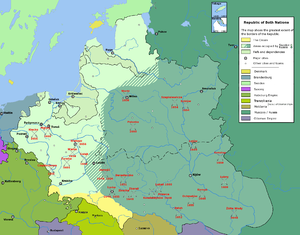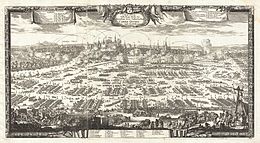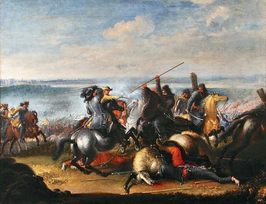Deluge (history)
This article needs additional citations for verification. (February 2024) |
| The Deluge | |||||||||
|---|---|---|---|---|---|---|---|---|---|
| Part of Northern Wars (Second Northern War and the 1654–1667 Russo-Polish War) | |||||||||
 The occupation of the Commonwealth by Sweden, Russia, Brandenburg and Khmelnytsky's Cossacks | |||||||||
| |||||||||
| Belligerents | |||||||||
|
| ||||||||
| Commanders and leaders | |||||||||
| Strength | |||||||||
| 69,000 | 191,000[5] | ||||||||
| Casualties and losses | |||||||||
| Total dead: 3,000,000–4,000,000[6] | |||||||||
The Deluge (
During the wars the Commonwealth lost approximately one third of its population as well as its status as a
Historical background
In 1648, Bohdan Khmelnytsky led a popular uprising of Zaporozhian Cossacks and Ukrainian peasants discontented with the rule of Polish and Lithuanian magnates. Although the initial phase of the rebellion ended (after much destruction) at the Battle of Berestechko (1651), it brought into focus the rivalry between Russia and the Commonwealth for hegemony over Ukraine and over the eastern Slavic lands in general. Thus, in October 1653, the Russian Zemsky Sobor declared war on the Commonwealth, and in June 1654 the forces of Tsar Alexis of Russia invaded the eastern half of Poland-Lithuania, starting the Russo-Polish War of 1654–1667. In the summer of 1654, the Russians managed to capture most important cities and strongholds of today's Belarus. Smolensk was captured after a siege on October 3, 1654. The Swedish Empire, which technically already was at war with the Commonwealth (a ceasefire agreement existed from 1629 and was prolonged from 1635 to 1661), invaded in July 1655 and occupied the remaining half of the country.
Swedish invasion
Background
Following the
The Polish–Lithuanian King John II Casimir (reigned 1648–68) lacked support among the Commonwealth nobility (
1655

In July 1655 two Swedish armies, operating from Swedish Pomerania and the Province of Pomerania, entered Greater Poland, one of the richest and most developed provinces of the Commonwealth, which had for centuries been unaffected by any military conflicts, and whose levée en masse had not been used to fighting. Greater Poland's noble camp, located in the valley of the Noteć river, near the town of Ujście, looked more like a large party, as the szlachta, gathered there to face the Swedish Army, was more interested in drinking. To make matters worse, two powerful magnates, the Voivode of Poznań Krzysztof Opaliński, and the Voivode of Kalisz, Andrzej Karol Grudziński, argued with each other whether to fight or to give up. Polish troops lacked gunpowder, cannons, and even food, which was stolen at local villages by hungry soldiers.[15]
After an easy Swedish victory at the
Meanwhile, in the Grand Duchy of Lithuania, whose eastern part had been occupied by another Swedish army under Magnus Gabriel De la Gardie since August 1655, Janusz Radziwiłł and his cousin Bogusław Radziwiłł signed the Union of Kėdainiai (October 20, 1655), which ended Lithuania's union with Poland. The decision of the Radziwiłłs was the result of the 1654 Russian invasion, as Janusz Radziwiłł accused the Poles of not helping the Lithuanians with the defence of the Grand Duchy. The Russian capture of Vilnius (August 9, 1655) and the subsequent slaughter of its residents convinced the Lithuanian nobility that Swedish protection was the best solution.[15] The situation of the Commonwealth was desperate, but hope appeared with the Truce of Vilna (November 3), in which Poland and the Tsardom of Russia formed an anti-Swedish alliance. With Russian forces attacking Sweden in Livonia (see Russo-Swedish War (1656–1658)), Poland finally had time to recoup and gather fresh forces. On October 12, 1655, with permission from King John Casimir, Frederick William, Elector of Brandenburg signed the Treaty of Rinsk, in which the Royal Prussian nobility agreed to allow Brandenburgian garrisons in their province to defend it against the Swedish invasion (the treaty did not include the cities of Gdańsk, Elbląg and Toruń). In November and December 1655 the Swedish army under Gustaf Otto Stenbock captured all the towns of Royal Prussia except for Gdańsk, Puck and Malbork.

To prevent John Casimir's return to Poland, Swedish units protected the border with Silesia. On November 18, 1655, the Swedes besieged the monastery at
1656
While in Krosno, the Polish king found out about the end of the siege of Jasna Góra, and about the death of Janusz Radziwiłł. On January 12, 1656, John Casimir left Krosno, and after three days, arrived at

On March 11, the Swedish army arrived at Jarosław, fighting its way across the San river. Charles Gustav sent some of his forces to capture Przemyśl, but on March 16 they returned to Jarosław without success. On March 22, the Swedish army set off northwards, along the San and Vistula rivers, back to Warsaw.[19] They were followed by units of Stefan Czarniecki and Aleksander Koniecpolski, and during the retreat, Polish troops supporting the invaders changed sides, joining the forces of John Casimir. On March 30, the starving, cold and tired Swedish army of 5,000 stopped near Sandomierz, which was already in Polish hands. The Swedes camped among the forests of Sandomierz Forest near Gorzyce, where they were quickly surrounded by approximately 23,000 Poles and Lithuanians. To help the besieged army, on March 27 Frederick VI left Warsaw with 2,500 reiters and dragoons, so John Casimir ordered the mounted units of Czarnecki and Lubomirski to face the margrave. Frederick's army was defeated on April 7 in the Battle of Warka. At Gorzyce, however, second-quality Polish forces remained, and the Swedish king managed to break out (April 5), and on April 13, Charles Gustav reached Warsaw. Meanwhile, the Polish king made the Lwów Oath (April 1), in which he entrusted the Commonwealth to the Blessed Virgin Mary's protection, and declared her 'The Queen of the Polish Crown'.
After the Battle of Warka, Czarniecki and Lubomirski decided to head towards Greater Poland and

Already in late 1655, Charles Gustav realized that it would be impossible for him to control the Commonwealth. The Swedish king decided to find allies, who would help him to divide Poland-Lithuania. On June 29, 1656, he signed the
1657
In 1653, the Transylvanian Hungarian ruler

After joining the Cossacks, Rákóczi decided not to attack Lwów, but set off towards Kraków, where the situation of the Swedish garrison under
The Ottomans were offended that George II Rakoczi, who was officially their vassal, did not ask their approval to attack Poland and did not want to open another war (in that time they tried to attack Venice through Dalmatia) but when he ignored them they ordered the Crimean Tatars to help the Polish troops and punish Rakoczi. They already replaced Rakoczi's vassal voivodes from Moldavia and Wallachia.[22]
On June 20, 1657, Stenbock was ordered by Charles X Gustav to abandon Rákóczi and head with his army to
On August 30, the Swedish garrison left Kraków, and throughout August and September 1657, all Swedish troops in Poland moved northwards, to
1658–1660

In the spring of 1658, the Polish army, together with its Austrian allies under
On July 1, 1658, the Sejm ordered the expulsion of the Polish Brethren, who were accused of collaborating with the Swedish invaders.
In 1659, the Swedish army still remaining in Poland under Lorens von der Linde was withdrawn to major Royal Prussian fortresses – Malbork, Głowa Gdańska, Grudziądz, Elbląg, and Brodnica. In August 1659, the Polish army captured Głowa and Grudziądz, and soon afterwards, the starving Swedish garrison at Brodnica surrendered. The siege of Malbork was continued, and Polish – Brandenburgian troops blocked Elbląg. In December 1659, the siege of Elbląg began. Meanwhile, in late 1658, the Polish–Russian truce ended when Russian forces under Ivan Andreyevich Khovansky (Tararui) and Jurij Aleksiejewicz Dołgorukow again attacked the Polish – Lithuanian units (see Russo-Polish War (1654–1667)). The Russians managed to capture large parts of the Commonwealth, but were later defeated in the Battle of Konotop and the Battle of Polonka.
On May 3, 1660, the Treaty of Oliva was signed, which ended the Polish–Swedish War. After the conclusion of the conflict, Poland–Lithuania initiated a large offensive against the Russians, who were beaten in the Battle of Chudnov. In 1661, Vilnius was recaptured (December 2), and in 1663–64, Polish forces invaded Left-bank Ukraine. The war with Russia ended with the Truce of Andrusovo (January 30, 1667).
Other conflicts
The Deluge was the climax of a series of wars that took place in Poland–Lithuania in the mid-17th century. The Commonwealth was first affected by the
With the
The Deluge brought to an end the era of Polish religious tolerance: mostly non-Catholic invaders antagonized the mostly
Outcome
The exact outcome of the Deluge is disputed, historians like Michael Fredholm von Essen state that the Deluge "did not end in a Swedish defeat" and that the Deluge "did not end in a Polish victory,[26] |- while Kevin Wang and James Lee Ray classify the war as a Swedish success diplomatically.[27] Polish politician and writer Jędrzej Giertych mentions it as a defensive victory against Sweden.[28] While Feliks Koneczny calls the result Status quo ante bellum and says that the whole war was an unnecessary bloodshed.[29] The Treaty of Oliva signed in 1660 meant that:[30] Poland gave up most of Livonia with Riga, retaining only part of it (Latgale - the south-eastern part of Livonia) which was in Russian hands at the time, until the Armistice of Andrusov in 1667. King John II Casimir Vasa renounced his right to claim the Swedish Throne for himself and those who succeeded him. He did, however, retain the title of King of Sweden for the rest of his life. Sweden had pledged to uphold freedom of trade in the Baltic. And that Sweden pledged to return the looted archives and libraries.
Destruction of the Commonwealth

The Swedish invasion affected the richest provinces of the Polish–Lithuanian Commonwealth (
Hubert Kowalski of the
Among others, Swedish troops stole such items as:
- both Polish and Lithuanian state records (Metrica Regni Poloniae),
- the royal library from Warsaw,
- libraries from Ujazdów Castle, Toruń, Bydgoszcz, Malbork, Poznań, Grudziądz, Gniezno, Lublin, Jarosław, Vilnius, Sandomierz, Radom, and Kraków, also archives and libraries from most towns of Royal Prussia. Most of the stolen books are kept in the University Library at Uppsala, the Royal Library at Stockholm, and private libraries of the Bielke, Oxenstierna, Rosenhahne, Wrangel and Brahe families,
- all Warsaw palaces – completely robbed were the Kazanowski Palace, the Ossoliński Palace, the Daniłłowicz Palace, the Primate Palace, the Bishophoric Palace, the Royal Palace and the Royal Castle,
- castles and churches, which were robbed and destroyed, as were almost all Polish towns; the most notable examples are Rabsztyn.
According to the estimates of Polish scholars I. Ihnatowicz, Z. Landau, A. Mączak and B. Zientara, the invasion by the Swedish army and its allies (Brandenburg-Prussia and Transilvania), resulted in the loss of 25% of the population in four core Polish provinces. Lesser Poland lost 23% of population, Mazovia 40% in villages and 70% in towns, Greater Poland 50% in villages and 60% in towns. Royal Prussia lost some 60% of its population.[34] The Commonwealth's population losses are estimated at between 30% and 50% in 1648–1660.[35]
In January 2013 Marek Poznański, a
Effect on the fate of the Commonwealth
One of the most notable effects of the devastating Deluge was the subsequent weakening of Poland's international standing. While Sweden destroyed more, Russia also took part and was second only to Sweden in the level of destruction.[citation needed] With the entire Polish nation crippled by the Swedes and Russians, Russia was able to rise, found the Russian Empire in the early 18th century and play a major role in the Partitions of Poland in the latter half of the 18th century.
In popular culture
The Deluge had a major effect on Poland, and there are several books describing the war. In 1886
In 2000, Renata Ocieczek wrote the book Czasy potopu szwedzkiego w literaturze polskiej (The time of the Swedish deluge in Polish literature),
See also
- Après nous le déluge(expression)
- The Deluge (novel)
- Kostka-Napierski Uprising
- List of wars between Russia and Sweden
- Northern Wars
- Polish–Swedish wars
- Tatar invasions
- Treaty of Hadiach
- Treaty of Oliva
References
- ISBN 963-326-337-9
- ^ ISBN 963-547-085-1
- ^ Palka, Piotr. "Potop szwedzki – jedna z największych tragedii w dziejach Polski". Wszystko co Najważniejsze (in Polish).
Although the Commonwealth was in the camp of the victors and defended its existence, it suffered unimaginable losses
- ^ "Adolf Johan". sok.riksarkivet.se. Retrieved September 13, 2023.
- ISBN 91-89442-57-1
- ^ Polska Akademia Nauk, Polska w okresie drugiej wojny północnej, 1957, p=271-280
- ^ Subtelny, Orest (1988). Ukraine. A history. Cambridge University Press. p. 104.
- ^ "Potop szwedzko-rosyjski, czyli III wojna północna (Swedish-Russian Deluge, or the Third Northern War)". polskieradio.pl. June 1, 2018. Archived from the original on January 6, 2018. Retrieved June 10, 2018.
- ISBN 0-521-54402-5. Archivedfrom the original on May 2, 2023. Retrieved September 16, 2018.
- ^ Zawadzki, Marcin. "Durham University Polish Society". Durham University. Archived from the original on August 21, 2007. Retrieved June 23, 2009.
During 'The Deluge', Commonwealth lost an estimated ⅓ of its population (proportionally higher losses than during World War II), and its status as a great power.
- ^ a b c ""Nikt tak nie ograbił Polski jak Szwedzi"". PolskieRadio.pl.
- ^ "Pierwsze zniszczenie Warszawy i jej odbudowa po potopie 1655–1696". www.wilanow-palac.pl. Archived from the original on January 27, 2020. Retrieved December 25, 2021.
- ^ "Potop szwedzki przyniósł Polsce straty o wartości 4 mld złotych". dzieje.pl. Archived from the original on June 27, 2018. Retrieved December 25, 2021.
- ^ "Co zgubiło Polskę podczas Potopu szwedzkiego – trzej zdrajcy, historiapolski.eu". Archived from the original on September 21, 2013. Retrieved February 7, 2013.
- ^ a b "Co zgubiło Polskę podczas Potopu szwedzkiego – trzej zdrajcy". historiapolski.eu (in Polish). January 8, 2013. Archived from the original on September 21, 2013. Retrieved February 7, 2013.
- ^ "Wstęp". www.zabytki.pl. Archived from the original on November 22, 2020. Retrieved August 17, 2012.
- ISBN 0-521-54402-5.
- ^ Jan Wimmer, Wojna polsko-szwedzka 1655–1660, Warsaw 1973, s. 156
- ^ a b c d Nagielski, Mirosław (December 25, 1990). "Warszawa 1656". Bellona. Archived from the original on May 2, 2023. Retrieved December 28, 2021 – via Google Books.
- ^ Kármán, Gábor. "II. Rákóczi György 1657. évi lengyelországi hadjáratának diplomáciai háttere [The diplomatic background of György Rákóczi II's 1657 Polish campaign]". Archived from the original on March 20, 2023. Retrieved November 5, 2020 – via www.academia.edu.
- ISBN 978-1851096725. Archivedfrom the original on May 2, 2023. Retrieved December 13, 2015 – via Google Books.
- ^ B. Szabó János. "Tanulmanyok". epa.oszk.hu/ (in Hungarian). Archived from the original on December 17, 2022. Retrieved November 26, 2022.
- ^ Włodarski (1993), p. 62.
- ISBN 978-1409403746. Archivedfrom the original on March 31, 2023. Retrieved June 27, 2019.
- ^ Such specifically anti-Jewish violence became known in the modern technical sense as a pogrom in the 19th century. For varying estimates of the numbers of Jews killed and for extensive sources, see the article on the Khmelnytsky Uprising.
- ISBN 9781915113603.
- ^ Wang, Kevin, and James Lee Ray. “Beginners and Winners: The Fate of Initiators of Interstate Wars Involving Great Powers Since 1495.” International Studies Quarterly, vol. 38, no. 1, 1994, pp. 139–54. JSTOR, https://doi.org/10.2307/2600875. Accessed 3 Mar. 2024.
- ^ Giertych, Jędrzej (1964). U źródel katastrofy dziejowej Polski (in Polish). p. 177.
- ISBN 9788382026658.
- ^ "Pokój w Oliwie 1660 - Jan II Kazimierz - pełnia alegorii i symboliki". May 6, 2021.
- ^ "Strona główna". Odkrywcy.pl. Archived from the original on December 25, 2021. Retrieved December 25, 2021.
- ^ "Wiadomości – Wiadomości w Onet – Najnowsze i Najważniejsze Wiadomości z Kraju i Świata". Onet Wiadomości. Archived from the original on April 16, 2013. Retrieved December 25, 2021.
- ^ "Grabieże szwedzkie w Polsce (1). Przyczyny, charakterystyka i skutki". Archived from the original on September 20, 2017. Retrieved September 1, 2012.
- ^ I. Ihnatowicz, Z. Landau, A. Mączak, B. Zientara Dzieje gospodarcze Polski do roku 1939. Wiedza Powszechna, Warszawa 1988, p. 233
- ISBN 978-1138009127.
- ^ "Poseł Ruchu Palikota chce odszkodowania za... Potop". Wprost. January 16, 2013. Archived from the original on December 25, 2021. Retrieved December 25, 2021.
- ^ "Avanti24.pl". Avanti24.pl. Archived from the original on December 25, 2021. Retrieved December 25, 2021.
- ^ "Publikacje | Wydawnictwo Uniwersytetu Śląskiego" (in Polish). Wydawnictwo.us.edu.pl. Archived from the original on December 3, 2013. Retrieved March 12, 2013.
- ^ Płosiński J. "Potop szwedzki na Podlasiu 1655–1657 – Płosiński J. – Księgarnia Odkrywcy, książki historyczne". Odk.pl. Archived from the original on June 2, 2013. Retrieved March 12, 2013.
External links
- Potop at IMDb
- Map of area occupied by Transylvania in 1657



